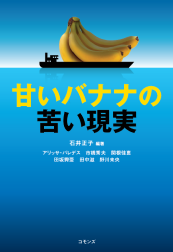
The Bitter Reality of Sweet Bananas
(Amai Banana no Nigai Genjitsu)
Tadaaki Ooe, Commons Press
Masako Ishii, Editor
Tokyo: Commons Press, 2020. 388 pages, 2500 yen plus tax.
Bananas are the most commonly enjoyed fruit in Japan. Largely grown on the Philippine island of Mindanao, they are cheap, easy to peel, and readily available on the shelves of convenience stores around the country. Why, exactly, are bananas so cheap? The Bitter Reality of Sweet Bananas (Amai Banana no Nigai Genjitsu, 388 pages, 2500 yen plus tax), edited by Masako Ishii, illuminates the hidden complexities behind this seemingly simple question. It considers how the low prices, while beneficial to Japanese consumers, are connected to low living standards among farmers and laborers where the fruit comes from.
For decades now, bananas have captured the public imagination. Yoshiyuki Tsurumi’s pathbreaking 1982 book Bananas and the Japanese (Banana to Nihonjin, Iwanami Shinsho) generated significant public response by depicting the conditions of laborers made to work for low wages and the rampant spray of dangerous pesticides. What is the situation like today, forty years after? The Bitter Reality of Sweet Bananas is a critical follow-up study that includes a historical account of how bananas came to be cultivated on Mindanao, as well as detailed field-based research on both the continuous and the emergent issues that banana production has caused. Since the publication of Tsurumi’s work, dominant multinational corporations have shifted in form. Laborers have fought against onerous contracts with the help of new political and legal strategies. Increasingly, aerially applied pesticides have harmed human and environmental health. The supply chains that bring bananas to our kitchen tables have also changed, becoming more complex. This book examines these topics in careful detail, helping readers gain not only an understanding of bananas themselves, but of broader changes in Philippine and Japanese society writ large.
Comprehensive in its account of a complex industry, yet relevant to issues of global concern, The Bitter Reality of Sweet Bananas prompts students, everyday consumers, and concerned citizens alike to ask themselves a number of pressing questions. Are we justified in enjoying bananas at so cheap a price? Should we not move towards “ethical” forms of consumption currently gaining worldwide popularity as it spreads outside of Europe? Through the prism of the humble banana, this book serves to introduce us to the broader problem of how we consume our food, both in Japan and beyond.
Contents
Introduction Little-Known Facts about a Well-Known Fruit
Masako Ishii
0.1 How Much Do We Really Know?
0.2 The Diversity of Philippine Varieties
0.3 Japanese Lives Through the Lens of Bananas
0.4 Questions Raised by Bananas and Japanese
0.5 Bananas in the 21st Century
Chapter 1 The Socio-Economic History of Export Bananas in Mindanao
Masako Ishii
1.1 Why Mindanao?
1.2 Spanish Colonization: The Colonized North and the Un-Colonized South
1.3 American Colonization for the Sake of Filipino Independence: The Rule of Landed Elites
1.4 The Influx of Settlers in Mindanao
1.5 The Influence of Japanese Military Occupation
1.6 From Independence to Martial Law: The Expansion of Export-Oriented Crops
Chapter 2 How are Export Philippine Bananas Produced?
2.1. Agribusiness and Industry Stakeholders: Changes Caused by the Comprehensive Agrarian Reform Law
Masako Ishii
2.1.1. Comprehensive Agrarian Reform Law and Agribusiness Venture Agreements
2.1.2. Growership Agreements and Lease Agreements
2.1.3. Changes of Multinational Corporations
2.1.4. Changes of Philippine Companies
2.1.5. Changes of Producers Engaged in Agreements with Agribusiness
2.1.6. The Problems of Growers Agreements and Lease Agreements
2.1.7. Low-Chemical Bananas Produced by Agribusiness
2.1.8. The Expansion and Diversification of Export Banana Industry
2.2. The Invention of ‘Highland Cultivated Bananas” and the Transformation of Mindanao’s Mountainsides
Alyssa Paredes
2.2.1. Discovering “Plantation One”
2.2.2. Supermarket Transformations and the Highland Imaginary
2.2.3. Higher Heights, Sweeter Bananas, Ever Bitter Realities
2.2.4 What the Highland Imaginary Forgets
Chapter 3 Realities of the Workers in Export Banana Industry
3.1. The Industry’s Periphery: Harvesting, Packing, Transporting, and Rejecting Bananas
Masako Ishii
3.1.1. The Export Industry in Figures
3.1.2. Forms of Labor on the Plantation
3.1.3. Realities of Workers not Reflected in Figures
3.1.4. From Plantation to Port: Transportation
3.1.5. “Reject” Bananas
3.2. Workers Fighting for Their Rights
Shigeru Tanaka
3.2.1. How Japanese NGOs Got Involved
3.2.2. Exploitation in the Packing Plants
3.2.3. Workers’ Continuing Their Fight Against Sumifru
3.2.4. Accomplishments by Japanese NGOs and Next Steps
Chapter 4 Pesticide Spray: Poison or Medicine?
4.1. The Pesticide Issue
Koa Tasaka
4.1.1. Pesticides Used on Banana Plantations
4.1.2. Pesticide Residues and Their Impacts on Children’s Health
4.1.3. The Impact of Pesticides on Local Residents
4.1.4. Guaranteeing a Healthy Environment and Safe Food for Future Generations
4.2 Crop Dusting and the Anti-Aerial Spray Movement
Alyssa Paredes
4.2.1 Chemical Cocktails
4.2.2. The Human Costs of Feeding Another Nation
4.2.3 Citizens Against Aerial Spraying
4.2.4. The Patronage of Banana Kings: Biting the Hands that Feeds You
4.2.5. “Here in Davao, We Only Have People”
Chapter 5 Reorganization of Multinational Agribusiness and New “Regulations”
Kae Sekine
5.1. Multinational Agribusiness and Bananas
5.2. Building and Reorganizing the Banana Industry
5.3. Appropriating Alternatives: A New Agribusiness Strategy
5.4. Constructing New “Regulations”
Chapter 6 The Journey to Japan’s Kitchen Tables
Hideo Ichihashi
6.1. The Banana Supply Chain
6.2. Exporting from the Philippines
6.3. Importing Philippine Bananas in Japan
6.4. Artificial Ripening: Industry Players and Process
6.5. Wholesale Market and the “Cold Chain” System: Rationalizing Domestic Distribution
6.6. From Retail Stores to Consumers: Mega Retailers and Their Branding Strategies
6.7. Who Benefits? Looking at Shared Profits
Chapter 7 Alternative Bananas: The Pursuit of Ethical Consumption
7.1.Toward a Fairer “People to People” Trade
Hideo Ichihashi
7.1.1. The Origins of “People to People” Banana Trade in Japan
7.1.2. “People to People” Trade and Fairtrade under Neoliberalism
7.2. Eating Ethically
Mio Nogawa
7.2.1. Alternative Bananas in Japan
7.2.2. Changing Multinational Banana Corporations
7.2.3. How to Eat Bananas Ethically
